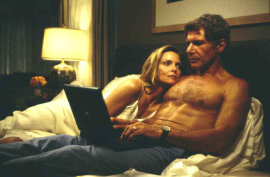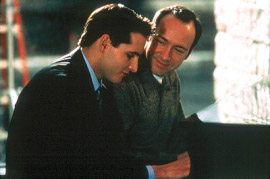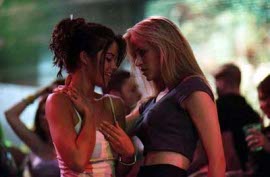 WHAT LIES BENEATH
WHAT LIES BENEATH
As far as I can tell, the only people who might enjoy Robert Zemeckis' supernatural thriller What Lies Beneath are the ones that haven't yet seen its trailer, but I'm not sure if anyone qualifies anymore. That's not just because the omnipresent trailer gives away far too many plot twists, but seeing the preview makes watching the entire first hour of the film pointless. Movie trailers have been getting worse and worse about providing too much information; this is the first time they came close to spoiling an entire movie for me.
(Note: If you are one of the three or four people who haven't seen the preview and are planning to see the movie, please skip this review.)
Most of us know going in that What Lies Beneath will be a ghost story where Harrison Ford's dead mistress haunts the home he shares with his wife (Michelle Pfeiffer), who sees and hears mysterious clues right from the start. The first hour of What Lies Beneath , however, is a Rear Window clone, in which we are led to believe that the spirit is actually that of the next-door neighbor, who Pfeiffer believes was killed by her husband. None of this pseudo-suspenseful, incredibly protracted setup works, though, because we know it's a red herring for the true identity of the apparition, and it made me, for one, impatient.
But does the film work if you're ignorant of its trailers? Not really. Zemeckis can be a tremendous talent, but he seems to have lost the knack for simply giving an audience a good time (which used to be his forte). His shock scenes are predictable and tame, the composition is heavy-handed, and the film's pacing is laborious; he's trying to turn a grungy genre setup into Art. The twists of the plot, too, are rather predictable, and in a particularly unsatisfying way; Zemeckis and screenwriter Clark Gregg use the film's supernatural angle to let the plotting get away with anything, no matter how nonsensical, and you can still foresee every "surprise" the film has in store.
The leads seem equally drained of life. Pfeiffer has her radiant realism, as usual, but her character is little more than a wan, panicky basket-case (until she comes alive, wearing a smoky red dress, in a scene that must be an homage to The Fabulous Baker Boys), and while the casting of Ford works for the film's plot machinations, he's in his dreary, Serious Actor mode for most of the film. Only Diana Scarwid, a hoot as Pfeiffer's hot tamale best friend, looks like she's having any fun; you perk up every time she appears. It's telling that you barely see her in those damn previews; she's the only element of What Lies Beneath that comes close to being a surprise.
 THE BIG KAHUNA
THE BIG KAHUNA
In The Big Kahuna, Kevin Spacey, Danny DeVito, and Peter Facinelli play Larry, Phil, and Bob, the three deepest and most verbose lubricant salesmen you're likely to encounter. Roger Rueff's adaptation of his play Hospitality Suite, with direction by John Swanbeck, is nothing more than an extended conversation between the three of them, as Larry and Phil attempt to score a major account with the titular client (referred to in the film, oddly enough, as the Grand Kahuna), and Bob acts as party pooper by, instead, using his time with the Kahuna to expound on his love for Christ. Clearly, action will take backseat to the three characters, the actors who play them, and their dialogue.
That's by no means a bad thing (in the summer months especially), and it would be easy to overlook the film's lack of visual finesse and crummy lighting if the dialogue really moved, as it did in the crackling Glengarry Glen Ross, an obvious inspiration for The Big Kahuna. Rueff, however, appears to write like David Mamet with a hangover; the deliberately repetitive and monotonous speechifying is wearying rather than enthralling, and practically nothing that comes out of these characters' mouths sounds like anything they would actually say. (Stagy as Mamet's dialogue usually is, it works dramatically.) And the raising of Big Themes - Religion, Suicide, Our Place in the World - feels like a half-baked attempt to up the ante, not-so-trenchant insights posing as depth. There's nothing wrong, in principle, with a filmed adaptation of a play, but there is if you get the feeling that the play itself wasn't worth preserving on film.
Among the cast, DeVito comes through with some really lovely pieces of acting, Spacey has his typically clever, well-thought-out line readings (which help mask the fact that he's played variants of his role dozens of times before), and Facinelli plays embarrassment and religious indignation nicely enough, but they're all deprived of juicy, show-stopping monologues, which is about the only thing you have to look forward to in a movie this drab. As an acting exercise, The Big Kahuna is diverting enough, but the movie itself, and the script in particular, leave them stranded.
 THE IN CROWD
THE IN CROWD
There are far worse ways to spend a couple hours than by watching beautiful people go crazy and try to kill each other, but you wouldn't know it from Mary Lambert's The In Crowd. This tale, which is kind of like what Beverly Hills 90210 would have been like if Brenda and Kelly slept with their therapists and had access to weaponry, would seem to have everything a campy thriller should: gorgeous, rich young people dressed in either prom attire or swimwear (or less); a subplot involving a missing sister and her doppelganger; shady grown-ups in positions of power; random acts of violence; and a pair of seething, bitchy Barbara Stanwyck wannabes at the center.
But the movie doesn't have the energy to play as camp; it barely has the energy to play. Missing the labyrinthine plot twists of the enjoyable Wild Things and the giggly effrontery of Cruel Intentions (a terrible movie, but more fun than most good ones), The In Crowd is exactly like a PG-13 version of those films. The characters are nasty but not that nasty, and so are the film's situations, murders, and plotting. Mary Lambert's fetishistic direction of the actors' torsos is good for some tasteless leering, and the movie finally achieves true camp when one of the leads begins digging up a corpse while wearing an evening gown, but the rest of The In Crowd is so draggy and humdrum - it actually takes itself seriously - that it's immediately forgettable; it gives Tacky Crap a bad name.








